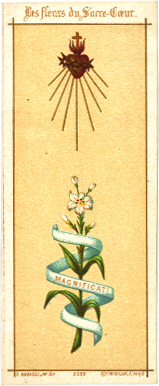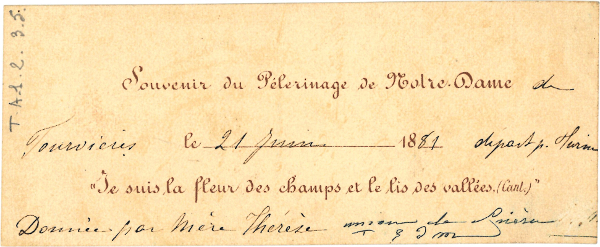Submitted by Wandrille on
You do well in propagating the devotion to the Sacred Heart of Jesus; how happy I should be if I were able to help you in this![1]
Oh, if the world understood the joy of a heart perfectly united to the Heart of Jesus! Alas, the world knows only pleasures, riches, honors and glory, all of which are obscured and disappear like smoke, leaving in the heart only emptiness, regret and bitter remorse.[2]
These two excerpts from Mother Thérèse’s letters say something about the importance that she accords on the devotion to the Sacred Heart of Jesus.
Studying in June the relationship that Mother Thérèse had with the devotion to the Heart of Jesus is not insignificant, since it is the month that is traditionally dedicated to it. Even more, this is a burning theme in the reality of today, since in March 2020 we saw this devotion renewed: the novenas to the Sacred Heart circulated and countries dedicated themselves to the Divine Heart at the height of the COVID-19 crisis. In History, in fact, the Sacred Heart was invoked as a refuge and salvation in public calamities: during the plague epidemics in the eighteenth century, by the Society of Jesus in its misfortunes (suppression in 1773), during the French Revolution, by soldiers during the First World War…
|
1826 |
Resumption of the beatification trial of Marguerite Mary Alacoque |
| 1856 | Extension to the Universal Church of the Feast of the Sacred Heart |
| 1864 | Beatification of Marguerite Mary |
| 1875 | Solemnity of the 2nd centenary of the great apparition of Jesus to Marguerite Mary and the beginning of the construction of the Basilica of the Sacré-Cœur in Paris |
The cult of the Sacred Heart of Jesus is ancient. We see the beginnings of it from the 11th century. Thus, the devotion as it is recognized and practiced by the Church, does not rest on the revelations of Marguerite Mary Alacoque, but the revelations she claimed to have received from Jesus are the basis of the movement of the devotion to the Heart of Jesus that developed from the 17th century. The process of beatification of Marguerite Mary gave a new impetus to this devotion in the 19th century, which has been described as the “century of the Sacred Heart[3]”.
It is therefore not surprising that Mother Thérèse’s spirituality is infused with devotion to the Heart of Jesus, a complete devotion that encompasses others.
First of all, the Incarnation: the object of devotion is first and foremost the Heart of the flesh of Jesus. Sometimes we see Mother Thérèse, in the spirit of the Exercises[4], following through thought the tribulations of Jesus.
The Heart of Flesh is also the symbol of divine love, divine mercy and divine goodness - themes dear to Mother Thérèse and frequently found in her correspondence. By extension, the object is the intimacy of Jesus.
Out of love, Jesus became man and died for the salvation of men. The devotion to his Heart is therefore closely related to the Passion (cf. Mother Thérèse who lived in tears on Good Friday) and to the Eucharist, renewal of the sacrifice of the Cross and the presence of Jesus (cf. Mother Thérèse’s devotion to the Eucharist), and also with the theme of sanctification.
Living to the rhythm of the Heart of Jesus
The calendar of the devotion is marked by an annual feast, a month dedicated to it and by the 1st Friday of each month. The feast of the Sacred Heart celebrated on the 3rd Friday after the Solemnity of Pentecost, commemorates Divine Mercy; while the “first 9 Fridays of the month” (first Fridays of 9 consecutive months) are dedicated to “making amends” to the Heart of Jesus asked by Him of Saint Marguerite Mary Alacoque in Paray-le-Monial. A Sister remembered that on the 1st Friday of the month, she always attended the sermon of the meeting of the ‘Communion Réparatrice’ (also called Guard of Honor) which took place in our chapel[6].
This calendar punctuates Mother Thérèse’s life, as her correspondence reveals[7].
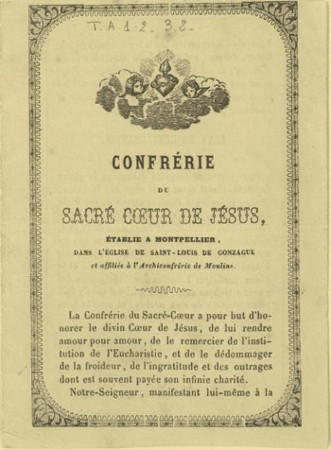
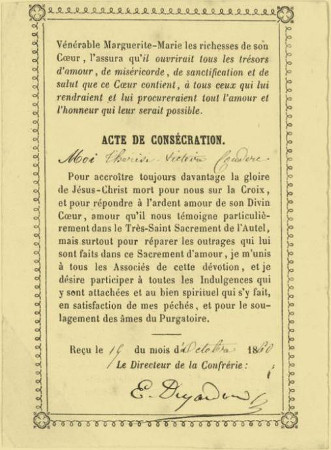
Image of affiliation of Mother Thérèse to the Confraternity of the Sacred Heart in Montpellier (front and back).
Her devotion to the Heart of Jesus
The sisters of the Congregation testified to the devotion of Mother Thérèse. Let us listen to them speak before the jury of the beatification process:
Another time she said to me, “We should cherish all that makes us suffer because it is a small portion of the Cross of Our Lord. Let us think how He suffered when He was in the midst of the streets of Jerusalem, being brought from court to court. He had the noose on his neck and his hands tied behind his back tightly. His enemies were so afraid that He would escape them. His heart was crushed, Our Lord, seeing the ingratitude of this crowd filled by Him with so many blessings. Try, my dear Sister, to think about this during the day when you work and tell Him, to comfort Him a little: sweet Heart of Jesus, suffering for us, be my love, give me the grace to love to be humiliated and despised that I may resemble you a little[8]”
She said to me: my dear little sister, sometimes there are great sufferings [in religious life], but we must remember that they are very small [compared] to those of Our Lord […] See the good God in others and entrust your sorrows to the good God who always has the ear of his merciful heart disposed and constantly repeating “My God and my all”[9].
Nothing, nor anyone outside or inside, distracted her uninterrupted conversation with God. She confided in God alone, she abandoned to his Heart, to His infinite goodness, the interests of what was more dear to her than herself: the Church and our Society [10].
She had the devotion to adore Our Lord in the heart of all men, visiting in spirit the whole earth, thus wanting to compensate her heavenly Spouse from the solitude where so many souls leave him yet where He dwells by the grace of Baptism[11] .
I noticed her devotion to the Sacred Heart of Jesus; to the prayer Anima Christi, she added in the second line: Sacred Heart of Jesus set me ablaze; she loved that we said so, saying with a smile that it did not spoil this prayer…
I was also struck by her solid piety to the Passion of Our Lord; towards the end of Lent, speaking of the morning meditation, she said to me: this author makes us contemplate for fifteen days Our Lord suspended on the Cross; it is too much, the forces are not enough; O good Master! Her gaze lifted up to heaven and all the expression of her face sufficiently completed her thought[12].
The objet of the devotion: the Divine Love for Men
|
The flowers of the Sacred Heart: Image given to Mother du Plessis (front and back) “Remembrance of the Pilgrimage of Our Lady of Fourvières on 21 June 1881 – departure for Turin” “I am the flower of the field and the lily of the valleys. (Song of Songs)” “Given by Mother Thérèse” “union of prayer”
|
“Behold the Heart that has so loved men that it has spared nothing, even to exhausting and consuming Itself, in order to testify to Its love; and in return, I receive from the greater part only ingratitude, by their irreverence and sacrilege, and by the coldness and contempt they have for Me in this Sacrament of Love” [the Eucharist], said Jesus showing his Heart to Marguerite Mary.
The devotion of the Heart of Jesus is the recognition of divine love, of divine goodness. A love that manifests itself up to the Cross, a sacrifice renewed in the Eucharist. By ignoring this divine love, men make the Heart of Jesus suffer. In reparation, he asks that once a week we have a part in his sadness at the Garden of Olives (message to Marguerite Mary).
during thanksgiving once again, as so many times before I rejoiced and suffered at the same time. I rejoiced at being united to the object of my love, but I also suffered very much from my inability to reciprocate such love, An infinitely lovable God deserves to be infinitely loved, and He are limited and unable to do so. The soul feels an extreme need to praise, to glorify, to thank and to love Him as He deserves to be loved. Yet she cannot do so. This inability causes indescribable pain, which becomes a kind of agony for the soul sees that it is sin. She envies the angels in heaven, who do not cease praising Him, but He is the God of men as well as the God of angels, is He not? And is not the same God infinitely lovable? And infinitely good? Why then is man reduced to this hard and sorrowful state of not being able to praise Him as perfectly as the angels? The afflicted soul receives the same answer - it is sin. Would it not be granted then to desire ardently to leave this sinful earth, and so end a life that can never be without some sin, which is the only obstacle to the possession of the Sovereign Good, the Infinite Good!
Sin and the Passion of our Lord are always the subjects that make the most impression upon me. Do pray, Very Reverend Mother, that these sentiments will bear fruit, and that I may correspond to all the graces I receive.[13]
How did Mother Thérèse get into the school of “that Heart who loved men so much”?
While it is reported to her that a preacher told a retreatant that he had entrusted her intentions to the prayers of a Sister [Mother Thérèse] who has a heart as big as Lyon, Mother Thérèse exclaimed: I do not have a heart as big as Lyon, my heart is as big as the world.
A Source of Love and Mercy
The month of the Heart of Jesus began; it is the source of all good, let us draw from it with humility and trust.[14]
May the Divine Heart of Jesus inflame your heart with His love and also pray to Him a little for me.[15]
Your letter was given to me on the eve of St. Theresa, and I had the consolation in the morning of believing that I had a little share in your prayers to obtain for me from the Heart of Jesus the grace for which you are begging - that my own may be inflamed with the fire of His love.[16]
At night, when I want to cast my eyes over the day, I see nothing but use1essness; nay, more than this, I see nothing but failure, defects, imperfections. Prayer, labor
are imperfect - nothing is well done.What shall I do, then? Well, so that I may not get discouraged (for I fear discouragement) I cast all this into the Heart of Jesus, which is an abyss of mercy, and I beg Him in His bounty, to repair, to perfect, to sanctify it all[17]
Imitating John: Approaching the Heart of Jesus to Draw Its Treasures
John is “the disciple whom Jesus loved, the one who, during the meal, leaned on Jesus' breast” (Jn 21:20, referring to Jn 13:25). A symbolic reading makes us understand that, by making the gesture of leaning towards the chest of Christ, where his human heart resides, John enters into the intimacy and the secrets of the divine Heart.
Symbolically, chest and heart merged to refer to the intimacy of Jesus. For St Augustine, for example, John’s rest on Christ’s chest meant that he had drunk the greatest secrets in the intimacy of the Heart of Jesus. For Origen, John the Evangelist drew the treasures of his knowledge and doctrine from the Heart of Jesus.
I do not forget, my dear brother, that we honor your patron Saint tomorrow. I do not know whether you will receive these lines in time, but you know beforehand that you sister will give you on that day all that it is in her power to give, and that I shall pray with my whole heart for you to this beloved one of the Divine Master, this trusted friend of the secrets of His Heart. 1 would like that He might teach me the way to enter into that Divine Sanctuary as far as he did, so that I too might learn there the science of love and sanctity. Beg this of him for me also, especially, my dear brother at the time when, like St. John, you have the happiness of drawing closer to Jesus than the rest of men..[18]
Today I should like to give myself the pleasure of spending the day with you.This morning you were present to my mind at Holy Mass and Communion, and I fervently prayed the privileged Apostle, your patron, to obtain for you - unless you have already obtained it - that fiullness of the sacerdotal spirit , which he drew from the Heart of the good Master and which makes saintly priests and apostles powerful in word and deed.[19]
I begged that dear favorite of the Good Master to protect in a special manner the one who has the honor of bearing his name and to bestow upon him together with the sacerdotal spirit, the fullness of that divine science which he drew from the Heart of Jesus.[20]
Let me wish you a happy feast, and be assured that I was very united to you today, honoring your well loved patron, and asking of him with my whole heart that he may ever deign to protect you and obtain for you from the Good Master the fullness of sacerdotal and apostolic spirit, which he possessed in so eminent a degree. I know, dear brother, that this request will please you and that these are gifts that you much desire, for they are indeed most desirable and useful. I hope that you. will also have prayed to him a little .for me, who would like to possess as he did, the secret of penetrating very deeply into our Lord's Heart, which is the source of all riches, and to be skilled as he was, in drawing from that divine treasury what is needed to enrich the poverty and misery, of which I am so keenly aware.[21]
In her correspondence, it is in the Heart of the Lord that she places her union with religious souls
This religious affection, which He Himself has cemented, in a very lively way, nor can it be altered either by time or place; whatever may happen it will endure eternally, because its source is in the Sacred Heart, where it will one day be consummated. This is one of the sweetest consideration of Christian and religious hope..[22]
Dear Sister, be assured of my religious affection, as I am very specially united to you in the Heart of Jesus.[23]
Wholly yours in the good Master's Heart[24]
Adieu, entirely united in the Heart of the Good Master Jesus[25]
Adieu in the Heart of the Good Master, Who visits you by His Cross[26]
Adieu, Reverend Mother, but believe that I will remain very united to you in the Heart of the Divine Master. It is, therefore, in Him that I remain with the most affectionate respects, Your very humble and obedient Sister Thérèse[27]
Adieu again, in the Heart of the Good Master - it is in Him that I am your very affectionate and devoted…[28]
Adieu, once more; ever very united in the Master's Heart and at the foot of His Cross[29]
I am obliged to leave you sooner than I should wish, but we can always find one another again in the good Master’s Heart. It is in His Heart that I beg you to believe me ever, with affectionate respect, my Reverend Mother, Your very devoted daughter, Thérèse[30]
And now I am obliged to bid you farewell on this bit of paper, but shall be always united to you from afar as close by, in the Heart of the Good Master.[31]
Adieu, my good Mother, I am obliged to stop my little chat with you,but I remain much united to you in the Good Master’s Heart.[32]
Adieu once more in the Heart of Jesus, in Him I remain united to you in heart.[33]
Adieu, but always much united in Our Lord’s Heart.[34]
Adieu, my Reverend Mother, I remain very united to you in the Heart of the good Master, and let this ever be our meeting-place.[35]
Adieu – I gladly accept the rendezvous you give me in the good Master’s Heart; please beg Him to deign to receive me in It and grant me the grace never to leave it.[36]
Adieu - always for God through the Hearts of Jesus and Mary Immaculate[37]
I am in union with your prayers, and in the Hearts of Jesus and Mary, to whom I commend you often[38]
|
Ancient costume crosses of the Cenacle (on the left) and of the coadjutrix Sisters of the Society of the Sacred Heart, front and back (RSCJ General Archive). |
The purpose of the Congregation
 This way of concluding a letter recalls how Father Terme ended his own, in the Heart of Jesus and of Mary. Proximity to the good priest on this theme does not stop there. Father Terme, who quotes the Heart of Jesus 106 times in the Rules of the Sisters, makes the glorification of this divine Heart the goal of the nascent Congregation, as Mother Thérèse explains to Bishop Bonnel, Bishop of Viviers. Father Terme largely copied the book of the Constitutions of the Religious of the Sacred Heart; he was also about to enter the Society of Jesus, which had been involved in the spread of the devotion for more than a century.
This way of concluding a letter recalls how Father Terme ended his own, in the Heart of Jesus and of Mary. Proximity to the good priest on this theme does not stop there. Father Terme, who quotes the Heart of Jesus 106 times in the Rules of the Sisters, makes the glorification of this divine Heart the goal of the nascent Congregation, as Mother Thérèse explains to Bishop Bonnel, Bishop of Viviers. Father Terme largely copied the book of the Constitutions of the Religious of the Sacred Heart; he was also about to enter the Society of Jesus, which had been involved in the spread of the devotion for more than a century.
Regarding our main effort, the principal and essential aim proposed by Father Terme in gathering us into a congregation is stated as follows in terms as clear as they are concise, in No. 6 of the abridged plan of the Institute of the Ladies of the Retreat or Sisters of St. Regis: “The means which the Society takes to glorify the Heart of Jesus in working for the sanctification of their neighbor are…[39]
Our good Father Rigaud went to make his retreat at Lyon, he remained there for three weeks; on his return he told us that a large part of the Constitutions is written, and that it is hoped that they will be finished at Easter, this gave us very great joy, being the announcement of this book of life which should be for us the expression of the divine will, how I long to have it and make of it the rule of our conduct in order that by this means we shall become more perfect and spouses according to the Heart of Jesus.[40]
As long as the work of Retreats endures, fervent prayers shall be offered to the Lord for the needs of that Society of Jesus, which ever ready to fly to the help of souls, causes the religion of Christ to flourish everywhere. We shall not cease to bless you, very Reverend Father, and to pray the Heart of Jesus, and fully satisfy our lively gratitude.[41]
I was very happy, dear Sister, to receive the good news which you gave me about the dear house of Tours. 1 take a lively part in your joy; that large retreat you mention show us your progress in works of zeal. May God be blessed for this, and may the Heart of Jesus, which you have drawn to youselves, also deign to send you a great number of souls, so that you may make It better known and loved..[42]
Paray-le-Monial: privileged place of the Heart of Jesus
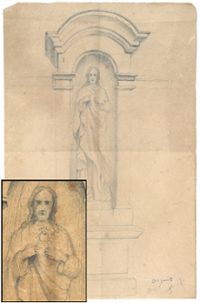 |
| Drawing of the statue of the Sacred Heart of the house of Tours. “Souvenir of the house of Tours to the good Mer Payan”. |
Since 1874, the Congregation has had a house in Paray-le-Monial, a city in France where in the 17th century Jesus revealed the secrets of his Heart to Marguerite Mary Alacocque. With her, the devotion developed, which passed in particular through the representation of the Sacred Heart (images, statues…).
It is He who gives the cross and it is He also who teaches and helps us to bear it. I feel very confident that the Heart of Jesus, which you have gone to invoke in that blessed and venerable place where He worked so many prodigies of grace and benediction, will console yours a little and consequently mine also which suffers with you […]. Our Mother Bertier especially begs you and entreats you to the best of her ability to make a pilgrimage to the Blessed Virgin, after you have finished that to the Sacred Heart.[43]
Note: In this letter, Mother Thérèse refers to the houses of Lyon and Paray. The Congregation was founded in connection with the pilgrimage to St Regis in La Louvesc (Mother Thérèse sometimes referred to it as “the holy mountain”). The second house was established in Lyon in connection with the desire to renew the devotion to the Virgin Mary on the hill of Fourvière. The house of Paray-le-Monial was founded at the moment when the beatification of Marguerite Mary Alacocque gave a new impetus to the devotion to the Heart of Jesus. In the same way, the house on the hill of Montmartre in Paris was built in connection with the basilica of the Sacred Heart which was in the planning stage.
We also have a statue of the Sacred Heart at Lyons in our chapel, and it is a great consolation for each one and all, since we are thus able to pray to Him in His Own house. I hope that He will hear our prayers, though we make no pilgrimage to Paray; happily, He is the same everywhere and He approved (we may not doubt it) our reasons for remaining in our solitude. [44]
I have had news from Sablières and therefore about our families, through the pastor, who came to purchase a beautiful statue of Our Lady of Lourdes, and also one of the Sacred Heart for his parish church.[45]
I am sending you a little picture of the Sacred Heart of Jesus, as you asked me to do; I wish it were more beautiful, but I have no other.[46]
I also gave them the little picture bearing the emblem of the Sacred Heart and the name of Mary, which they understood and admired very much.[47]
Thank you for the pretty picture of the Heart of Jesus. In exchange, I shall ask that Divine Heart to impart its riches to you.[48]
Similarities between the Spirituality of Marguerite Mary and the “Se Livrer” of Mother Thérèse
|
If you desire to live entirely for Our Lord and to arrive at the perfection He desires of you, you must sacrifice yourself and all that depends upon you without any reserve to His Sacred Heart. You must will only by His Will ; love with His affections ; act only by His light […] for it must suffice us that His Divine Heart be pleased, loved, and glorified.
Marguerite Mary Alacoque, letter to Mother de Soudeilles, August 24, 1686 |
the great means by which one may enter into the path of perfection and of holiness is to surrender oneself to our good God. [...] To surrender oneself is to die to everything and to self, to be no longer concerned with self except to keep it continually turned toward God. To surrender oneself is […] no longer to seek one's own satisfaction, but solely the divine good pleasure. It should be added that to surrender oneself is also to follow that spirit of detachment which clings to nothing, neither to persons nor to things, neither to time nor to place. It means to adhere to everything, to accept everything, to submit to everything. Mother Thérèse, Se Livrer (To Surrender Oneself), 1864
|
[1] Letter to her nephew Abbe Léon Couderc, June 30, 1880.
[2] To her nephew Abbe Léon Couderc [without a date].
[3] Msgr. d’Hulst, founder of the Catholic University of Paris, in 1896.
[4] The Spiritual Exercises, by presenting Jesus in a human way and inviting to know him intimately, direct souls to the Heart of Jesus.
Early on, devotees of the Heart of Jesus were found in the Society of Jesus, even before Marguerite Mary Alacoque: saints Aloysius Gonzaga and Peter Canisius, Louis Lallemant… In the preface to his Spiritual Doctrine by Fr. Champion, he sums up a spirituality that Mother Thérèse echoes: “The spirit of annihilation shown by the Son of God in His Incarnation was the model of humility which he proposed to himself; and the Sacred Heart of the Incarnate Word was the school in which he studied the practice of this virtue. It was in this school and from this divine Master that he learned this sublime lesson of humility to forget himself and to remain buried in his own nothingness.”
Another known author of the Society who resonated with Mother Thérèse was Jacques Nouet (1608-1680). In a paragraph devoted to the “means of uniting our hearts to that of Jesus, and our love to his own through perfect likeness” (in The Man of Prayer), he wrote: “We must love only God in the creature, and we must love the creature only for God”.
A General of the Society, Fr. Vincent Caraffa (1585-1649), also showed his devotion in the works of piety he wrote. Among the fervent Jesuits of the Heart of Jesus closest to us is Fr. Arrupe.
[5] She is a mystical religious of the Order of the Visitation, an inspiration for devotion to the Sacred Heart. The spirituality developed from her visions, and it blossomed especially in the second half of the life of Mother Thérèse, who prayed to the Blessed (beatified in 1864 and canonized in 1920). Cf. Letter to R. M. Dambuent, 18 October 1873.
[6] Memories of Mother Bertha Schmidt (she lived in Lyon with Mother Thérèse from 4 Sept. 1870 to 3 June 1872), Diocesan Trial in Lyon.
[7] For example, letter to Mother Dambuent, June 7, 1869, for the month and feast; to Mother Lysie Adam, May 29, 1862; and to Miss Pauline Dussol, June 7, 1857, for the feast; from La Louvesc to Sr Agnès at Plagnal, Jan. 14, 1836, and to V.R. Mother de Larochenégly, Montpellier, 13 Feb. 1864, for the 1st Friday of the month.
[8] Sr Agarit, 1887 (Written Memories).
[9] Sr Jacqueline.
[10] V.R.M. Marie Aimé Lautier, Ordinary Trial of Malines.
[11] Memories of Mother Pauline Petit given during the trial in Lyon (1930).
[12] Memories of Mother Pauline Petit given at the trial in Lyon (1930). Mother Pauline Petit entered in 1850. Between 1850 and 1867 she lived with Mother Thérèse «from time to time» in Lyon, La Louvesc and Montpellier.
[13] To Mother de Larochenégly, August 7, 1867.
[14] To Miss Pauline Dussol, June 7, 1857.
[15] To her nephew Abbe Léon Couderc, Jan. 2, 1876
[16] To Very Reverend Mother Marie Aimée Lautier, from Lyon, Oct. 16, 1881.
[17] To Very Reverend Mother Marie Aimée Lautier, from Lyon, Oct. 17, 1882.
[18] To her brother Abbe Jean, Dec. 26, 1961.
[19] To her brother Abbe Jean, Dec. 27, 1866.
[20] To her brother Abbe Jean, Dec. 27, 1868.
[21] To her brother Abbe Jean, Dec. 27, 1869.
[22] To Mother Dambuent, Sept. 8, 1866.
[23] To Mother Félicie Chartier, May 21, 1863.
[24] To Mother Davin, Feb. 13, 1870.
[25] To Mother Ursule Payan, October 17, 1867.
[26] To Mother Dambuent, April 7, 1866.
[27] To Mother Bertier in Tours, Dec. 27, 1878.
[28] To Mother Pauline Petit, January 15, 1868.
[29] To Mother Chartier, Superior at Montpellier, April 2, 1867.
[30] To Mother Dambuent, August 3, 1865.
[31] To Mother Ursule Payan, Assistant General, November 18, 1866.
[32] To Mother Laure de Lafarge , November 5, 1872.
[33] To Sr Marguerite Hérique, April 21, 1867.
[34] To Mother Petit, April 14, 1868.
[35] To Mother M de Fraix, Oct. 19, 1881.
[36] To her nephew Abbe Léon Couderc, February 20, 1882.
[37] To her nephew Léon Couderc, priest, Nov. 28, 1884.
[38] To her nephew Adrien Rouvier, Jan. 12, 1873.
[39] Rough draft of her letter to Bishop Bonnel of Viviers, July 1836.
[40] To Sr Agnès, Jan. 14, 1836.
[41] Rough draft of her letter to Reverend Father Renault, Provincial of the Jesuits of France, Dec. 1834.
[42] To Mother Cécile de Roubin in Tours, Nov. 11, 1873.
[43] To Mother de Larochenégly, Assistant General, in Paray-le-Monial, June 15, 1878.
[44] To Mother Cécile de Roubin à Tours, November 11, 1873.
[45] To her nephew Abbe Rouvier, Oct. 23, 1881.
[46] To her nephew Léon Couderc, seminarian, Jan. 2, 1876.
[47] To Mother Lysie Adam, Jan. 28, 1876.
[48] To Mother Ursule Payan, Oct. 17, 1873.

